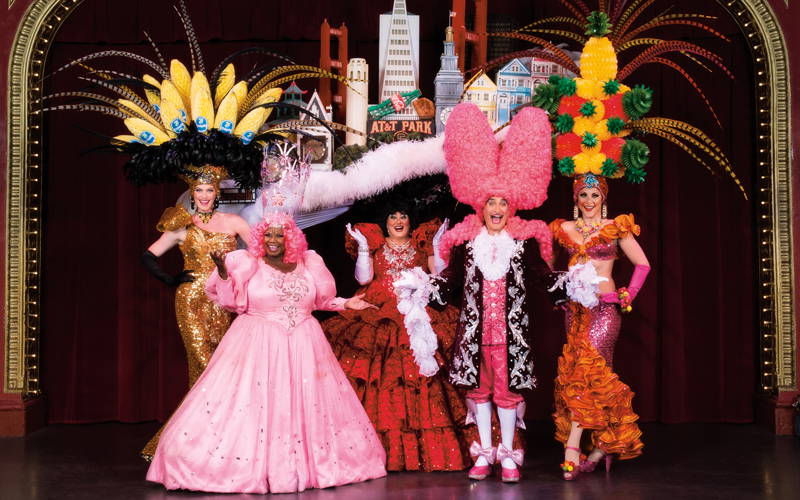Every year, my family travels from San Francisco to the sunny island-country of Singapore where I’m from. We first made this trip as a family in 2016, when my daughter, Katherine, was 2 months old. For those who don’t know, the first leg of the plane ride is 16 hours long, and the second is 4 hours long. We had planned a one-hour layover in Hong Kong that would give us just enough time to walk at a reasonable pace from one gate to another.
At that time, social media was ablaze in conversation about a mother who had prepared little Ziplock baggies containing earplugs and conciliatory candy to prepare them for her toddler whom she was sure would be a screaming mess. She even included a handwritten note of preemptive apology to calm the angry fellow travelers.
As amused as I was with that viral post, I neither had the time nor finances to produce those little packages, and went on my first flight unarmed. Surprisingly, nothing much happened. My small person barely cried, never screamed, and slept through all the take-offs and landings.
We had survived 10,000 miles, and an 18-hour time difference. Hurrah!
Since then, we’ve done this trip another two times with our daughter, at 14 months old, and more recently, when she was slightly over 2-years-old. Here are our family’s tips:
1. Know what you need, and what you can get.
Milk - For nursing mothers, just bring yourself. Don’t forget to wear something that’s warm (planes can get cold), but nursing friendly. If you’re bottle-feeding, pack milk powder into pre-packaged compartments. If you’ll use regular hot water, you can always approach a flight stewardess for that. But if you need bottled water, whether hot or not, prepare them beforehand, and prepare for accidents. (I saw a mother lose half a bottle of water, and her sanity, when turbulence happened.) Some airlines also have milk powder if you run out with an unusually hungry child, but you’re better off bringing extra.
Snacks - Bring some snacks for your child, by all means. A mouth that’s eating is usually quiet, but find out beforehand what kinds of snacks your airline provides. Some airlines provide everything from crackers and granola bars to fruit and sandwiches for travelers, while others charge for water. Don’t let your child load up on sugar, especially because there isn’t much space for your toddler to run off their energy. Combine that with the compressed cabin air and sugar can make a flight more stressful than ever.
Cost & Value - We have only done this flight by Singapore Airlines. It is usually more pricey than other airlines, but not only are we familiar with the quality of service we are paying for, we also purchase our flights more than half a year in advance. Buy your flights ahead of time if you can because this not only usually means spending less on tickets for the whole family, you’ll probably also be able to choose the best seats for the team without spending more. Got an infant? Ask for a seat with a bassinet the airline will provide, or for a seat with more legroom.
Priority & Benefits - If you’re traveling with a child, most airlines will also announce to let your family board before other travelers. So, alert the airline staff at check in, and while you’re waiting to board the plane. Your family will be able to secure cabin space overhead for all your carry-ons, grab a few magazines from the shared magazine rack, and take the time to settle in while other travelers engage in the chaos of finding their seat and hustling for overhead space. Airlines also usually have small toys and gifts for children on board, ranging from stuffed toys to coloring books, so ask away for a little piece of memorabilia if you don’t yet have enough toys to step on at home.
2. Entertainment: What do you need?
You know your child best. For some, visual media whether from a digital device or in-flight screen provides great entertainment. But for those of you, who like us, don’t own televisions, and have a child who has little interest in screen time, here’s what helped:
Books - Be prepared to have to engage your child, read to them, and/ or make characters come alive for her.
An Amuse Box - Days before flying with our 14-month-old, I picked up a fabric box laying on the sidewalk that had a soft toy airplane, flower, elephant, fish and frog. My husband added any and all small toys he could find to the box, including wind-up toys, a lego figurine of Darth Vader, bouncy balls, finger puppets and dollhouse dolls. This kept her entertained for quite a while. When the trip was over, our daughter forgot about it, and we put it aside. One year later, when we took it out again on the plane, it kept her entertained for a while with renewed interest.
Busy Bags - Toddlers are prone to dropping things, so I wouldn’t advice handing your toddler any activity with little pieces. This means no marbles, buttons, or beads. But there are tons of busy bags you can prepare for your little person. Your child can practice lacing cardboard, dress up a doll, or match colors to clothe pegs while remaining in their window seat. Check Pinterest for busy bag ideas and stock up for use even on rainy days. They can contain affordable materials such as ice cream sticks and knitting yarn.
Coloring books - Maybe your toddler can color a picture. But mine just colors. This means spreading color over as much surface of a picture as possible. I’ve found that while Melissa & Doug Coloring books didn’t really keep her busy at 14 months, it definitely did at two years. What’s great is that it uses just water, so there’s no need to worry about a mess.
Take a walk - don’t be afraid to let your child go on a walk down the aisles. The biggest issue we encountered was that my child wanted to touch the leg of every person she passed, regardless whether they were awake, at 14 months. At two years of age, other travelers either ignored us on our way to the galley to find another snack, or wanted to engage her in play. In most cases, the plane was stable enough for her to loosen those leg muscles, and a toilet break helped her refocus on being in her seat.
Get That Window - Katherine loved having the window seat. Not only did it allow us to point out landmarks as we took off and landed, pointing out boats and other planes, she could also lean her head on a pillow against the side side of the cabin as she fell asleep. It also allowed us to separate her from other children who were crying or screaming due to changes in air pressure and other issues. In cases where the window seat isn’t available, consider purchasing an inflatable leg rest after checking with the airline if they are permitted. The legrests allow toddlers to lie down for better sleep.
3. The Toilet-Trainers Dilemma
Our two-year-old was just a sophomore at using the toilet when we had to take her on the 20 hour journey. So what we decided to do was put her in diapers, but make the effort to bring her on bathroom trips regularly. However, it gave us the reassurance that if she needed to go number 1 or number 2, and our plane encountered some turbulence, we wouldn’t be stuck pretending that the smell wasn’t coming from our row.
4. Preparing for the flight back
Other than doing the usual stuff mentioned above, my husband and I usually refresh the items in our Amuse Box mentioned above at our destination. The items then also serve as a reminder to the toddler of the things they have seen, and becomes a sort of Montessori Continent box, that contains objects and photographs from the country.
For example, a trip to Japan could involve a child creating a continent/ country box that includes a small Japanese doll, a scrap of fabric commonly used to make traditional Japanese kimonos, a postcard of a Japanese ceremony the family may have seen, a map of Japan, a picture of the family at Mount Fuji or at a hotspring, a keychain in the design of a Japanese bento box or other similar items.
5. Don’t fight the jet lag
When you move back and forth across 18 time zones, it’s inevitable your body is confused. Fighting it is will only drag it out. Instead, here’s how you can make the transition back home easier:
Sleep - Sleep as much as you can on the plane. Adults, take it from an international journalist who spent too much time in airports and on planes, your body doesn’t need that glass of wine or liquor. Skip that, drink lots of water and hydrate.
Plan your recovery - Be kind to your bodies. Airplane rides are stressful on the body, nevermind trying to squeeze everything into your luggage and hoping they aren’t overweight and getting through customs. We tend to forget that we need at least a full day of recovery to be our best selves again. So, even before traveling, tell your bosses and your kid’s teachers that you guys will be back at least a day after getting off that plane. There’s no point in showing up tired, grumpy and generally unpleasant as you struggle with the lethargy.
Vitamin C - Take some, and give some to your child, before boarding that plane. My husband and I estimated that we shared 10 bathrooms with about 500 people over 20 hours. There’s really no place to hide from that person with the dormant virus or the flu without symptoms. What you can do, though, is prepare your body for battle.
And finally, as a closing piece of advice for this blog post on how to survive a plane ride with your toddler, always check your food. No matter how careful airlines are, they sometimes serve food that’s bad. I once received chicken that was not properly cooked. As I picked through the pink, my husband kept secret that he had not checked his. 20 hours later, he was quite ill after just arriving home. Food poisoning can happen anywhere, especially while traveling, and the last thing anyone needs, during or after a trip, is a sick partner or toddler.
Bon voyage!
Blog Written by Expert Traveller with Toddler, Pearly Tan


































































